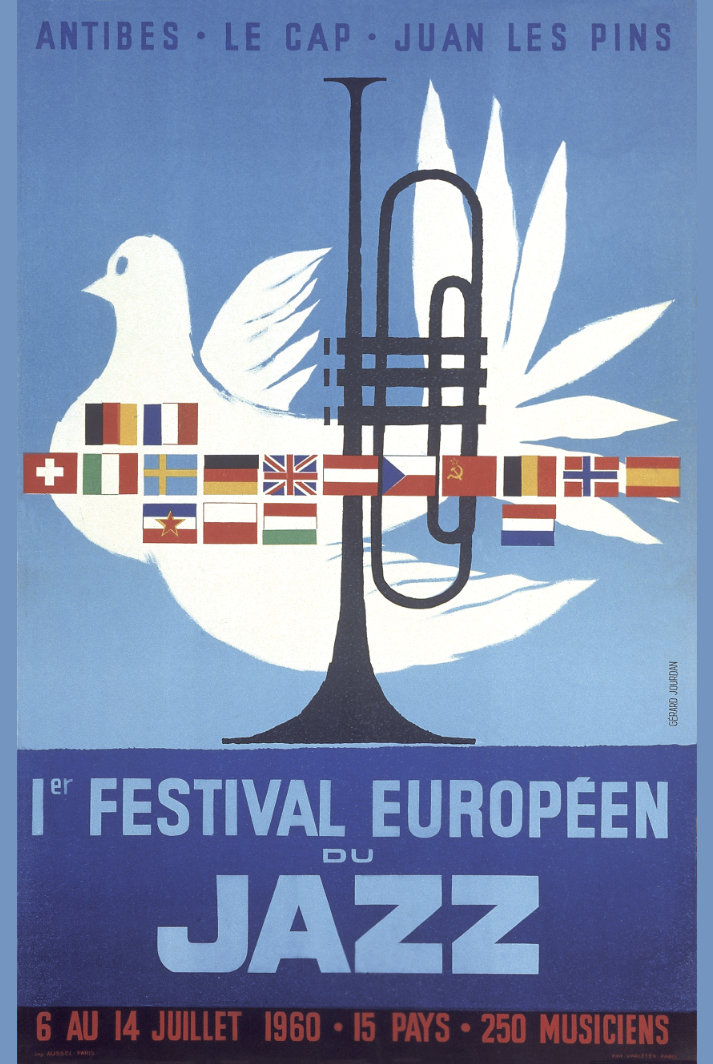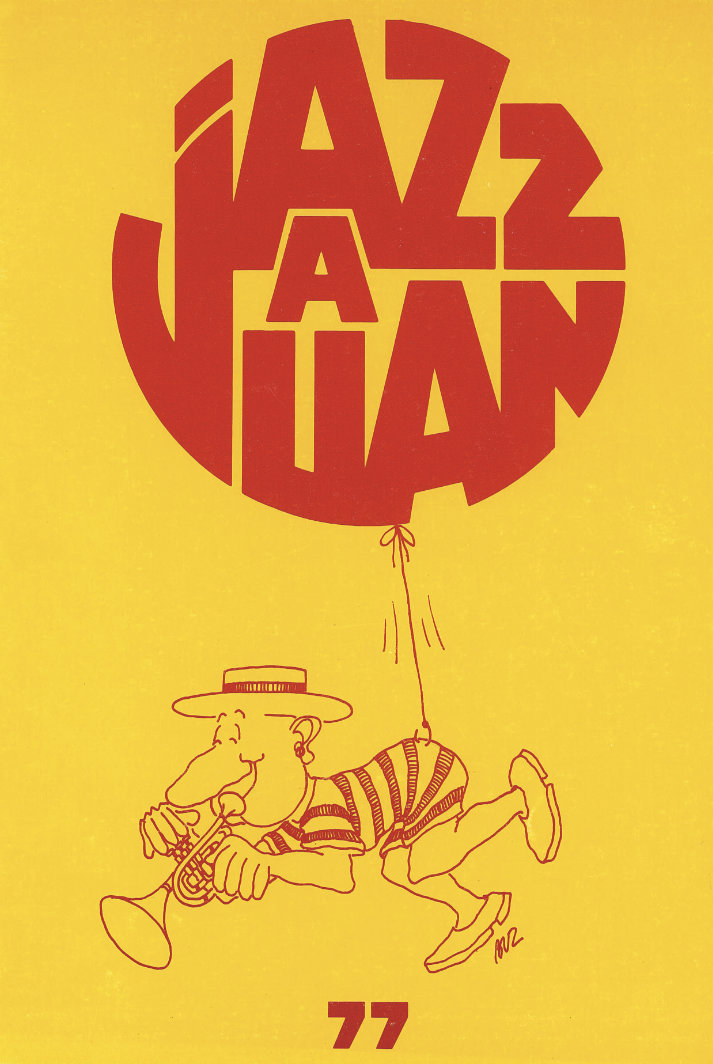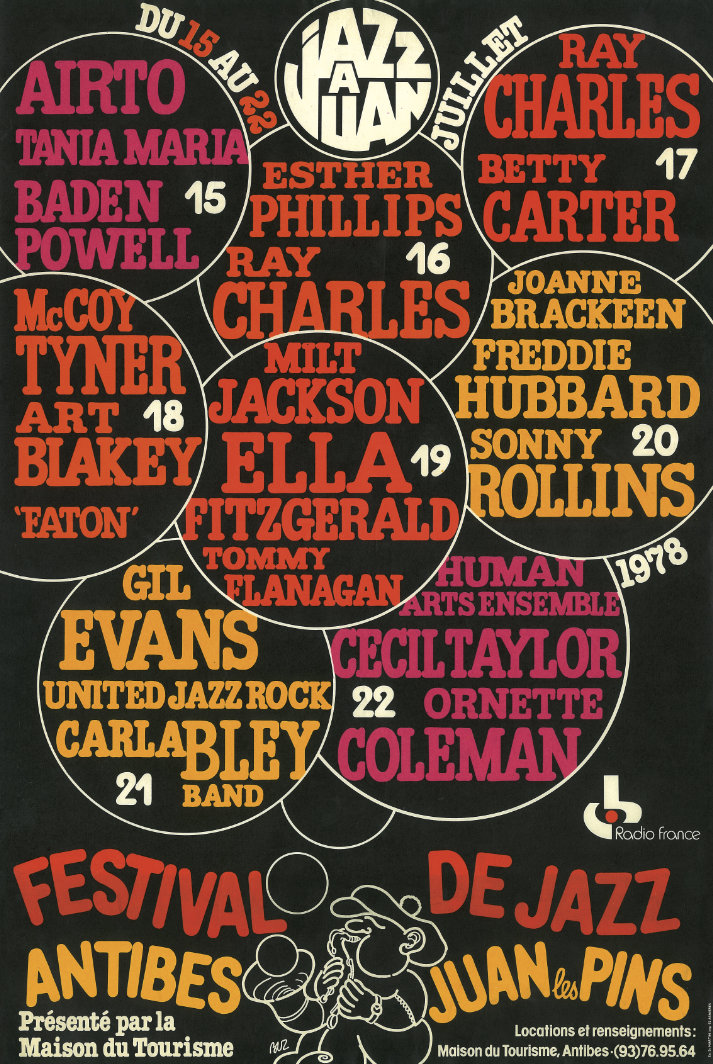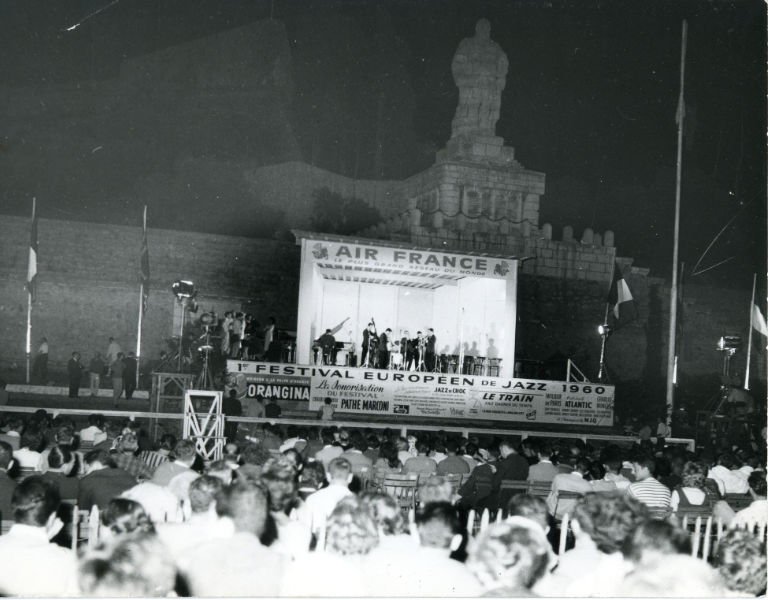The festival
Birth of a festival
A little history…
From the beginning of the 20th century, Juan-les-Pins was THE fashionable seaside resort on the Côte d’Azur, very popular with Americans. In 1959, the city of Antibes Juan-les-Pins was in mourning for the most French of New Orleans jazzmen: Sidney Bechet. The city’s inhabitants all remember his grandiose, hyped-up wedding and the crazy parade through the streets of Antibes which followed the ceremony in 1951.
At a time when, in Europe, jazz was confined to listening to records and being presented in a few clubs, Jacques Souplet and Jacques Hebey decided to present on stage the already legendary players in the Jazz saga. And so the Antibes Jazz Festival saw the light of day on 7 July 1960, under the auspices of the Mayor of the city, Pierre Delmas, and the general public could discover their heroes on stage in person.
While its longevity makes this music festival the oldest Jazz festival in Europe, its originality lies above all, at the time and still today, in being on the lookout for and presenting, next to the “Stars” of the moment, the “stars” of tomorrow.
The 1st edition of the Festival was held simultaneously at the Fort Carré stadium in Antibes and at the Pinède Gould in Juan-les-Pins which became, from the concert of 10 July 1960, given in homage to Sidney Bechet, the preferred venue for musicians and organisers. From the 2nd edition, the festival would only be held in Juan-les-Pins, in the most beautiful setting imaginable, under the century-old pines with the Mediterranean in the background. Exceptionally, some concerts would take place at the Palais-des-Congrès in Juan-les-Pins.






If I hadn’t passed through Antibes, Montreux wouldn’t exist.
Claude Nobs, founder of the Montreux Jazz Festival

La gestion du festival
Twice in its history, the festival couldn’t take place, in the early 1970s and in 2020, but Jazz notes still rang out between the walls of the town in the form of parades or concerts… In Antibes Juan-les-Pins, it’s unthinkable not to listen to Jazz in summer.
Since 1971, management of the festival has been entrusted to the Maison du Tourisme, which over time became the Tourist and Conventions Office, which produces and organises the entire event.
Juan is a beautiful place where all the musicians in the world want to play!
Herbie Hancock
Jazz à Juan over time
The festival built its legend from the first editions by welcoming the revolutionary Charlie Mingus, the “Genius” Ray Charles for his first concert in Europe, Miles Davis, who made the event at each of his appearances, Ella Fitzgerald who improvised a memorable duet with a cicada, John Coltrane and his now legendary interpretation of Love Supreme. In 1968, after the “Coltrane shock” and while the controversy raged on all levels, it was the irresistible epic of free, before the apogee of Jazz Rock and fusion in 1976.
The legend continued when an impressive “collection” of pianists were featured in 1981 – Michel Petrucciani, McCoy Tyner, Chick Corea and Keith Jarrett and the revelation Al Jarreau, the duo of Sarah Vaughan with Michel Legrand in 1982, the extraordinary duo Stanley Clarke and Miroslav Vitous in 1984, performances by Carlos Santana and the great Jessie Norman… Not forgetting, of course, the fabulous concerts of three loyal performers: Dizzy Gillespie, Stan Getz and Sonny Rollins. Jazz à Juan knows some loyal musicians, loyal because they’re welcomed by a grateful public in a magnificent setting: we’ll mention just Keith Jarrett, Roy Hargrove, Dee Dee Bridgewater, Marcus Miller, Herbie Hancock, BB King, Maceo Parker, Melody Gardot and Ibrahim Maalouf.


A mixed festival
Diversity of genres and programming
Both chic, elitist, popular, but also eclectic, since 1960, Jazz à Juan has presented all types of jazz. It’s always stuck to its course, that of scheduling jazz in all its magnitude while allowing several openings for musical “cousins”.
The festival works in recognition of mixed and improvised music from all over the world, and for constantly renewed jazz: New Orleans, Gospel, Blues, Swing, Be-bop, Latin Jazz, Cool Jazz, Hard-Bop, Free Jazz, Jazz-Rock, Modern Jazz or Electro-Jazz. It’s given pride of place to the young generation of Jazz since its creation.
Discs recorded during a Jazz à Juan concert:
1963: Dizzy Gillespie, New Wave, (tracks 3 and 6), Philips Records
1964: Ella Fitzgerald, Ella at Juan-Les-Pins, Verve
1965: Woody Herman, Live in Antibes, (Import)
1965: John Coltrane, Live in Antibes, France Radio Classic Concerts
1967: Ella Fitzgerald and Duke Ellington, Ella and Duke at the Cote D’Azur, Verve
1967: Duke Ellington, Soul Call, Verve
1968: Mahalia Jackson, Live In Antibes, 1968, (Import)
1968: Count Basie, Live in Antibes-1968, France Radio Classic Concerts
1968: Pharoah Sanders, Juan les Pins Jazz festival, 1968, Timeless Live Recordings
1969: Miles Davis, Miles Davis in Europe, CBS. Reissue in 1993 under the 1969 title: Miles, Festival de Juan-les-Pins, Sony
1971: Charles Lloyd, The Flowering, Atlantic Records
1973: Marvin Peterson, Hannibal In Antibes, Enja
1974: Muddy Waters, Live In Antibes, 1974, France Radio Classic Concerts
1974: Freddy King, Live In Antibes, 1974, France Radio Classic Concerts
1975: Billy Harper Quintet – Antibes ’75, Sam Records
1976: Charles Mingus, Mingus at Antibes, Atlantic Records
1977: Lee Konitz, Jazz à Juan, 1974, SteepleChase
1981: René Urtreger, En Direct d’Antibes, Emarcy
1995: Dee Dee Bridgewater, Live in Antibes & Juan-Les-Pins, DVD, 149 min, Universal Music
2003: Keith Jarrett, Up for It, ECM
2004: Archie Shepp and the Full Moon Ensemble, Live In Antibes Vol. 1 and 2, Abraxas
2011: Preservation Hall Jazz Band, Festival international de jazz d’Antibes-Juan les Pins-Vol 1 & 2, Sony
2011: Christian Vander Alien Trio, Antibes 1983, Seventh New


